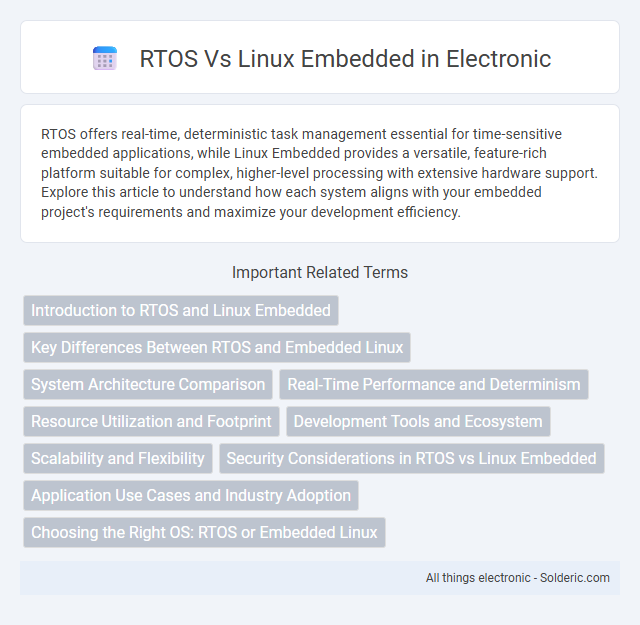RTOS offers real-time, deterministic task management essential for time-sensitive embedded applications, while Linux Embedded provides a versatile, feature-rich platform suitable for complex, higher-level processing with extensive hardware support. Explore this article to understand how each system aligns with your embedded project's requirements and maximize your development efficiency.
Comparison Table
| Feature | RTOS | Linux Embedded |
|---|---|---|
| Real-Time Performance | Deterministic, low latency | Non-deterministic, higher latency |
| Kernel Type | Microkernel or Monolithic (real-time) | Monolithic |
| Memory Footprint | Small, optimized for embedded devices | Larger, requires more RAM |
| Scheduling | Priority-based, preemptive real-time scheduling | Fair scheduler with time-sharing |
| Use Cases | Industrial automation, automotive, medical devices | Complex applications, multimedia, IoT gateways |
| Development Complexity | Lower, focused on deterministic tasks | Higher, supports complex multitasking |
| Device Drivers | Limited, specific hardware support | Extensive hardware support |
| File System Support | Basic or custom file systems | Full file system support (ext4, FAT, etc.) |
| Open Source Availability | Available (e.g., FreeRTOS), often commercial | Primarily open source (Linux Kernel) |
| Power Consumption | Optimized for low power | Higher power consumption |
Introduction to RTOS and Linux Embedded
RTOS (Real-Time Operating System) provides deterministic, low-latency task scheduling essential for time-critical applications in embedded systems, ensuring predictable response times. Linux Embedded, a versatile open-source platform, supports complex applications with extensive hardware compatibility and a rich ecosystem, although it may have higher latency compared to RTOS. Choosing between RTOS and Linux Embedded depends on requirements such as real-time performance, resource constraints, and application complexity.
Key Differences Between RTOS and Embedded Linux
RTOS (Real-Time Operating System) prioritizes deterministic task execution with minimal latency, essential for time-critical applications, while Embedded Linux offers a more feature-rich, general-purpose environment but with less predictable timing. RTOS typically consumes fewer resources, providing a lightweight kernel optimized for real-time responsiveness, whereas Embedded Linux supports complex networking, file systems, and user interfaces due to its larger footprint. Your choice depends on the requirement for strict timing control in RTOS or the extensive functionality and hardware support present in Embedded Linux.
System Architecture Comparison
RTOS features a microkernel or monolithic kernel optimized for real-time deterministic performance with minimal interrupt latency, supporting prioritized task scheduling and inter-task communication mechanisms vital for time-sensitive applications. Linux Embedded relies on a monolithic kernel designed for general-purpose computing, integrating extensive device driver support and user-space processes, but its non-deterministic scheduling introduces latency unsuitable for hard real-time constraints. System architecture differences impact resource utilization, with RTOS enabling minimal footprint and predictable behavior, while Linux Embedded offers richer functionality and complex multitasking at the expense of real-time precision.
Real-Time Performance and Determinism
RTOS offers superior real-time performance and deterministic behavior, ensuring predictable task execution within strict timing constraints, which is critical for safety-critical and time-sensitive embedded applications. Linux Embedded, while highly flexible and feature-rich, typically relies on a non-preemptive kernel, making it less suitable for applications requiring hard real-time guarantees. Your choice between RTOS and Linux Embedded should consider the need for precise timing and reliability in your embedded system's real-time operations.
Resource Utilization and Footprint
RTOS platforms typically feature minimal resource utilization and a compact footprint, optimized for real-time performance in memory-constrained environments, often requiring just a few kilobytes of RAM and flash storage. In contrast, Linux Embedded systems demand significantly larger resources, including several megabytes of RAM and storage, due to their complex kernel and feature-rich architecture. This substantial resource overhead impacts boot times and power consumption, making RTOS more suitable for ultra-low-power, latency-sensitive applications where efficient resource use is critical.
Development Tools and Ecosystem
RTOS environments feature lightweight, purpose-built development tools optimized for real-time performance, such as specialized debuggers and trace analyzers, enabling precise task scheduling and timing analysis. In contrast, Linux Embedded benefits from a vast ecosystem with rich development tools like GCC, GDB, and extensive open-source libraries that support complex applications and networking stacks. The RTOS ecosystem often emphasizes certification and robustness for safety-critical systems, while Linux Embedded offers scalable frameworks and community-driven support for rapid development and prototyping.
Scalability and Flexibility
RTOS offers superior scalability and deterministic behavior essential for real-time applications, enabling precise task management and timing control in resource-constrained environments. Linux Embedded provides greater flexibility with extensive hardware support, rich software libraries, and multitasking capabilities, making it suitable for complex, feature-rich devices. RTOS excels in predictable performance for critical systems, while Linux Embedded accommodates scalable solutions requiring robust networking and user interface functionalities.
Security Considerations in RTOS vs Linux Embedded
RTOS offers deterministic real-time performance with minimal attack surfaces, making it ideal for security-critical embedded applications where predictable timing and low latency are paramount. Linux Embedded provides a robust security framework with advanced features like SELinux and AppArmor, but its larger codebase increases complexity and potential vulnerabilities. Your choice depends on whether strict real-time security guarantees or extensive security feature sets are the priority for your embedded system.
Application Use Cases and Industry Adoption
RTOS excels in real-time, safety-critical applications like automotive control systems, medical devices, and industrial automation due to its predictable timing and minimal latency. Linux Embedded is favored in complex IoT, consumer electronics, and telecommunications for its rich features, extensive libraries, and strong community support. Choosing between RTOS and Linux Embedded depends on your application's real-time performance needs and industry-specific requirements, with RTOS dominating sectors requiring deterministic behavior and Linux Embedded preferred for scalable, feature-rich solutions.
Choosing the Right OS: RTOS or Embedded Linux
Choosing the right OS between RTOS and Embedded Linux depends on your project's real-time performance requirements and resource constraints. RTOS offers deterministic behavior with low latency, ideal for time-critical applications, while Embedded Linux provides a rich set of features and greater flexibility for complex systems with ample processing power. Your decision should balance the need for strict timing control against the benefits of advanced networking, filesystem support, and scalability.
RTOS vs Linux Embedded Infographic

 solderic.com
solderic.com